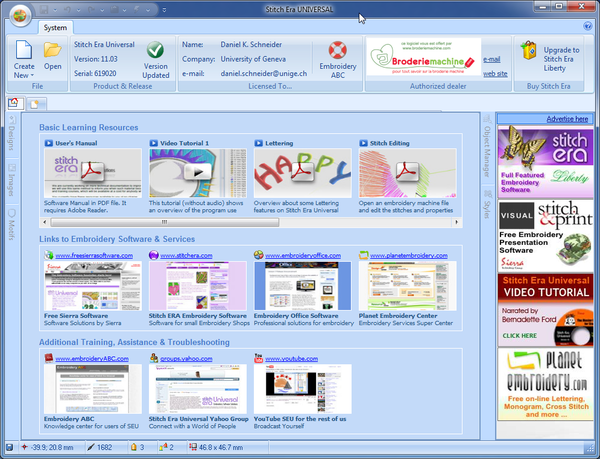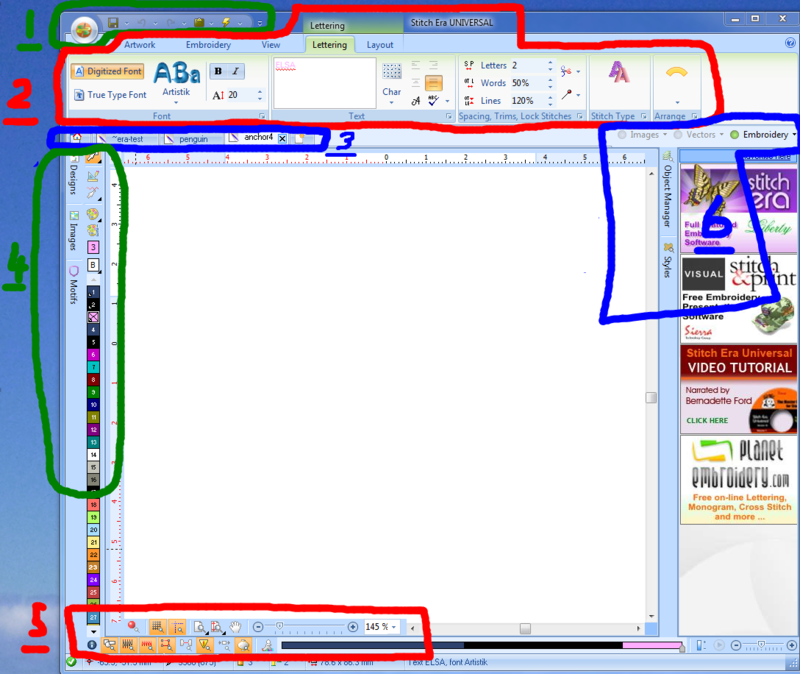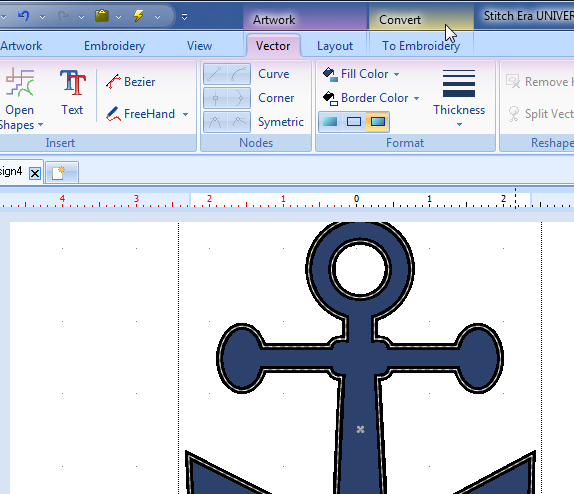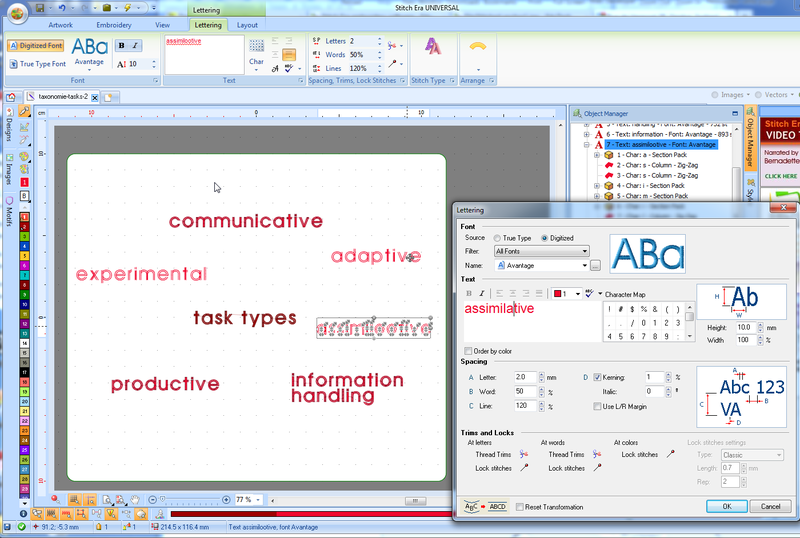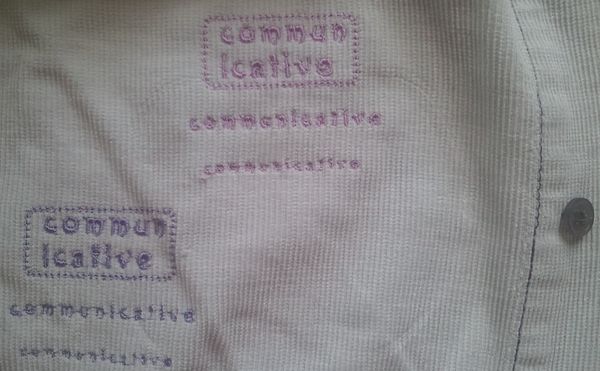Stitch Era embroidery software
<pageby nominor="false" comments="false"/>
Introduction
Stitch Era Universal (sometimes abbreviated as SEU by Sierra is an advanced free embroidery design software that you can get under certain conditions:
- You only get it from an authorized dealer. E.g. since I live in France, I got it from the french authorized reseller. For countries like Switzerland that do not have authorized resellers you will have to send some mail to headquarters.
- You need to register and obtain a license number and key (and renew these periodically)
- The application must be conntected to the Internet permanently and there are advertizements. However they don' flicker, just eat up some space to the right.
- The free version limits stitch count to 40'000 stitches. That's a fairly large design, unless you fill up all the space with stitches.
The purpose of this entry is to help people get going past the very first steps. It will never become a stitch era manual. I just will use it to write down a few tricks and tips while I learn myself ... - Daniel K. Schneider 16:49, 16 May 2011 (CEST).
Download and installation
Stitch Era Universal is distributed by Authorized Distributors (either via CD or online) unless you are lucky to live in a country without. Installation and use requires a permanent Internet connection. Software contains advertising. Download can take a long time and you need to find a download site for your country (e.g. for France use Annika's site). You first have to install a downloader, then a download the > 400 MB installation files with the downloader program.
After going through the complicated finding-a-place-to-download, the double download and authentication, we found that this program runs fine on Win 7 64 bit.
Issues
- The program may sometimes enter infinite error loops with different types of mistakes: We encoutered:
- vector our of bounds errors (e.g. the program tries to draw outsite its window).
- Access violations
In these cases, the program must be killed with the Windows task manager. This happend to us in several situations, but always when moving/resizing stitching or combined stitching/vector objects in the work area.
- After a longer pause it will take some time to wake up
Therefore: Save before moving/resizing operations, although there is an automatic autosave that automatically will open the safe file after a crash.
The user interface
At start up, Stitch Era software that does have a license and a key should look like this:
- Before you click on Create New, download the manual and read some of it (first item under Basic Learning Resources in this startup screen).
- For a new design, select quick start using a simple wizard. You then can specify textile and hoop size (ordered by machines).
The interface is fairly complex and we really suggest reading at least parts of the manual and/or looking at some training videos.
- You have links to both in the start-up screen, else see below.
Below is a very provisional tools overview.
- File Menu button and quick access toolbar
- Main tools / Ribbon bar. These can change contextually.
- Artwork
- Allows to import bitmaps and vector graphics
- Draw vector shapes that do not include stitching information yet. This is maybe the preferred way to start drawings as opposed to directly inserting stitch parts available through the Embroidery tab or Designs->Create sections.
- Embroidery
- Define materials and hoop
- Retrieve patterns
- Allows to insert stitch parts
- View
- Allows to define various view parameters (including a refresh button and a satellite view)
- Includes snap and measure tools
- Body
- Change parameters of a fill (shapes)
- Border
- Change parameters of a stroke (lines)
- Layout (Rescale, rotation, etc. but also repetitions)
- Ribbon bars on top (shows type of selected object and help you understanding what you can do with it).
- Area (shows what you can change for a selected part, i.e Body+Border+Layout)
- Path (shows what you can change for a stroke, i.e. border + layout)
- Lettering (shows that you can change lettering and layout)
- Block (shows that you selected more than one object)
- Artwork (shows what you can do with selected vector graphics)
- Convert (shows that you could convert a vector image to stitches)
- Package ?
- Artwork
- Document bar
- Allows to open/close documents and create new ones.
- Clicking on the home icon will bring you to the start page.
- Create and edit tools / color management / color palette
- Designs
- Select Object (press mouse button for a while for options): Press this to return to select mode !
- Create Sections: Define how to create new different kinds of parts, i.e. fills vs. strokes, kind of stitches.
- Edit Stitches
- Images (changes contextually, e.g.:
- When stitchable object is selected: Change Color palette and optimize Needles
- When a vector object is selected: Change color, etc.
- Motifs
- Provide information about "needles" that will be used. In single needle machine, think of this as threads that you will have to change.
- Double-click allows to change parameters, e.g. the color, thread make/model and number.
- Designs
- Display and reference controls (at the bottom)
- Object manager and Styles (to the right)
- The three little toggle buttons (images, vectors and embroidery) allow to show/hide these types of objects
- The object manager gives you fine grained control over both vector objects and stitch objects.
Simple digitizing
We found that digitizing vector graphics is much easier than bitmaps and this is not a surprise of course. Vector graphics are clean mathematical descriptions of shapes (lines and fills) whereas bitmaps are just collections of pixels. Therefore, if ever you can, avoid starting with *.jpg, *.gif, *.png pictures. Digitizing photographs is another issue and much more difficult since you also will have to reduce colors, despeckle, smooth lines, etc.
Below is the rough procedure for creating embroidery stitch files from simple vector graphics. Stitch Era seems to be a fairly sophisticated embroidery suite and it can do much more. But starting with imported graphics files is probably the kind of stuff other beginners would want to try first, so here is the rough procedure:
(1) Get a vector image
- Finding clip art on the web is quite a nightmare (read Clipart for some tips).
- We got ours from http://openclipart.org, i.e. this nice anchor. Click on "Download SVG" and then just save as anchor.svg somewhere. Read about SVG, the only nice vector format on the web.
(2) Import the vector graphics to STitch Era
- Open the vector image in Inkscape (a free program), Illustrator CS5 (I tested with both) or another vector program that can copy a drawing to the Windows clipboard.
- Still in the drawing program, select all (Ctrl-A in most programs) or the part you wish to stitch and copy it (CTRL-C in most programs)
- Then go to Stitch Era and click on paste EMF vector. Notice: The "Get from Application" feature doesn't work for me, which is too bad since EMF is lossy with respect to AI or SVG format. Probably, because I got a fairly new version of Illustrator.
- You now should see something like this:
(3) Optional: Edit the vector graphics
- You now have the choice to edit this a bit if needed. In principle you better do any editing in the drawing program. Anyhow, I clicked on ungroup all in order to get rid of the white lines which are not needed for stitching. This was actually a bit tricky since I couldn't see these parts (for a reason I don't understand). I therefore selected the blue part (click) and moved it way to the left and then selected the empty area with the white stuff and hit delete...
- I then made the borders a bit fatter with the "Thickness" pulldown menu. You can define thickness for parts (not combined objects)
- Then move on to auto-punching (I guess it's called that way), but save the file first.
(4) Convert to stitches
- If not already done so, select the object first, e.g. move the cursor into the drawing area and press CTRL-A
- Click on Convert (notice how the tabs change in the program). If you can't see the "Convert button", make sure you really selected the object on the screen !
- You now can choose between letting the program decide for you or vectorize fills (areas) and strokes (lines) yourself. Try Art to Stitch (intelligent) first. Untick the little round Vectors button to the right in order to see the stitches.
- If you are unhappy, you could hit CTRL-Z and change for instance the stitch pattern (tab in the popup menu after clicking on Art to Stitch).
(5) Add other clipart or lettering or whatever
- ... as you like
(6) Export
- Save this file if not already done so. Keep the *.dsg file for re-editing
- Click on the "File" button (top left) and export to the desired machine format, e.g. I chose *.jef for Elna/Janome.
The result
Not too bad for my second digitalization / stitching (the first one was a smaller anchor without the lettering). There are some mistakes, probably because the tissue moved. I didn't iron a stabilizing tissue underneath. Also, the anchor head doesn't look as good since the bobbin underneath ran out of thread and I forgot to backtrack after changing it I think.
A picture showing the machine "printing" it, is in the Elna 8300 article.
Simple drawing
To create vector graphics, click on Artwork (top menu). Vector graphics must be converted in same way as imported graphics, i.e. fully automated or half manually by selecting "Art to stitch" area or line only. Press the yellow flash in the quick toolbar once you are happy with the selected parameters
Besides importing graphics, you can create vector graphics with five tools:
- Closed shapes (a set of predefined shapes)
- Open Shapes (a set of predefined pathes)
- Text (not lettering..)
- Bezier: draw so-called Bezier curves
- FreeHand: draw freehand (with optional smoothing)
Once you inserted objects with any of these tools you can modify them in several ways:
- Clicking on an object shows controls that you can move to change the path or shape
- Pressing the CTRL button allows to rotate most parts
- Right-click (context menu) gives various options
Vectors are defined by several types of nodes
- ... more to come
Constructive solid geometry
- You also can define new shapes by combining shapes like in some CAD/CAM programs, e.g. you could subtract one shape from another like creating moon with two circles. Use the Combine menu for that.
Lettering
There two basic ways for creating letters
- Start from vector letters and then convert to stitches. This may work with large letters and even then not lead to optimal results since digitizing stitcheable letters is an art by itself ....
- Use specialized lettering software that can produce stitches from letters. In the SEU program, Words are represented as Stitching objects of type Text. Each text then is composed of either simple characters (like a "c") or composed characters like an "m". This probably also depends on the font. There are two kinds of built-in lettering fonts:
- Special purpose digitized "artistic fonts"
- Standard digitized true type fonts.
Good lettering software will recompute the stitches when you change font type and/or font size.
In SEU digitized words are editable, i.e. you can fix spelling mistakes (see below)
Word editing
The Lettering panel that allows to edit text, is available through the context menu (select the object, right click on the object and select Text properties) or as expansion of the text panel in the main menu bar.
This panel allows to edit text, to change fonts, size, distances. In addition you may specify trims and locks.
Tips:
- We found it very good voodoo to tick Reset Transformation after changing sizes and distances. Somehow, the Reprocess All (lightning button in the quick access bar) doesn't reprocess all the time. E.g. for small letters (smaller than recommended), the textbox is not resized without ticking "reset transformation".
How small can one print ?
After a little test we believe that one could go as low as 5mm in height under the following conditions:
- fabric must be flat
- fabric must be stabilized
- contrast between fabric and letters must be high
- Stitching speed should be slowed down a bit
The following picture shows a test that doesn't respect these principles:
- Top right uses the the digitized Artistik font with sizes 10mm, 7mm and 5mm
- Bottom left group used the True Type Arial Rounded MT font with the same sizes
Open questions:
- Is is possible to print digitized fonts otherwise than with a zig-zag technique, i.e. use straight lines instead ? Below 1mm, zig-zag does seem to have problems. We tried to convert stitching to vectors and then to redigitize, but at some point the program crashed. Otherwise one also could change the stitch patterns. To explore more ....
- How much work is editing at the stitch level in order to fix some badly converted characters? We found that "w"'s are not well liked when working with "tiny" Arial and similar fonts.
Drawing embroidery objects
Instead of drawing vector objects first you can directly create embroidery objects.
- Select embroidery in the main menu bar on top or select "Create Sections" in the little design panel to the left.
Links
- Official
- Stitch Era Universal Website #1
- stitchera website #2
- EmbroideryABC webiste #3
- Official documentation and forums
- Stitch era distributes a nice 250 page printable PDF manual (see the start page). Last time checked it was here.
- The Stitch era community formus
- Yahoo group StitchEraUniversal
- YouTube training and demo videos
- Tutorials in other languages
- Tutoriels vidéo et traduction française du manuel par Chantal.
